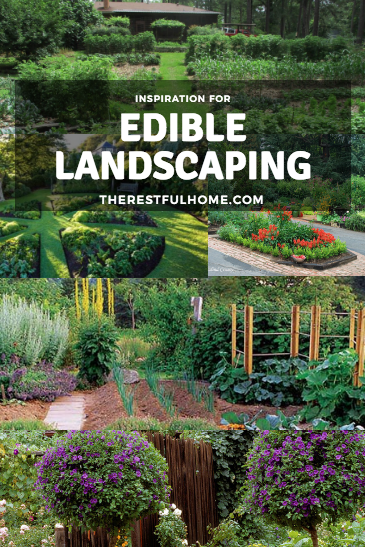 Yes, it’s almost winter right now–not most people’s idea of a great gardening time. Even for those of us living in the South, the growing season has mostly come to a halt. A potential edible landscape–“foodscape,” as some say–is probably more of a springtime thought than a wintertime dream.
Yes, it’s almost winter right now–not most people’s idea of a great gardening time. Even for those of us living in the South, the growing season has mostly come to a halt. A potential edible landscape–“foodscape,” as some say–is probably more of a springtime thought than a wintertime dream.
However, right now is the time for planning and getting the soil ready! Rather than waiting until March to prepare your beds, begin building up your soil and stacking leaf piles for mulch right now. If you’re in the already-snowy northland, pull out your notebooks or graph paper and start charting out how your garden is going to look next year.
I grew up gardening, although I was more of a go-fer than a thinker/planner. When we started our little gardens in our back yard, I wasn’t sure what I was doing. I could remember a couple of rules from my dad, an expert by now in organic gardening:
- Start a compost pile.
- Mulch, mulch, mulch. Mulch and compost bring earthworms. And worms are the best thing that ever happened to a garden.
Mulching was easier said than done, though, in our 1/4 acre plot of land with very few leaves. That’s why this year, I’ll be scrounging leaves from all my neighbors who want to get rid of them.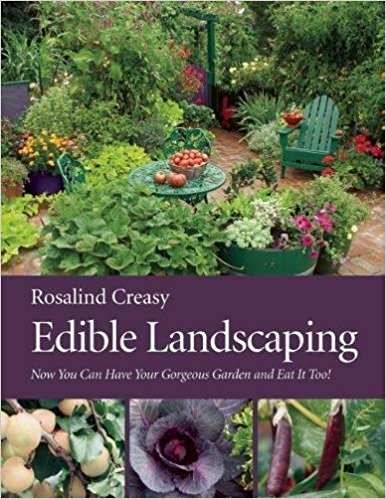
My inspiration right now comes from reading (well–studying) Rosalind Creasy’s book, Edible Landscaping (among other gardening books). My gardening background features mostly straight rows of raised beds, with squared corners for maximum production. (My parents had six kids to feed, after all.) I have always loved circles, but I didn’t think they had a place in vegetable gardens. Rosalind Creasy, however, shows that you can bring together your love for beautiful plants and designs with your desire to be more self-sustaining. My husband and I are now hard at work on creating an edible landscape (not just a plain old vegetable garden) in our back yard. (He wants me to practice before I add to my little herb garden in the front yard where all the neighbors can see!)
Following is a collection of photos with descriptions for people who, like me, want to replace at least some of their lawn with beautiful, productive plots of land. Winter months, after all, are for inspiration…and cups of hot cocoa. We can be glad that we have a break from summer heat here in the South, while looking forward to the stunning edible landscapes we will be able to create if we get a good start now!
-
The Vibrant Driveway
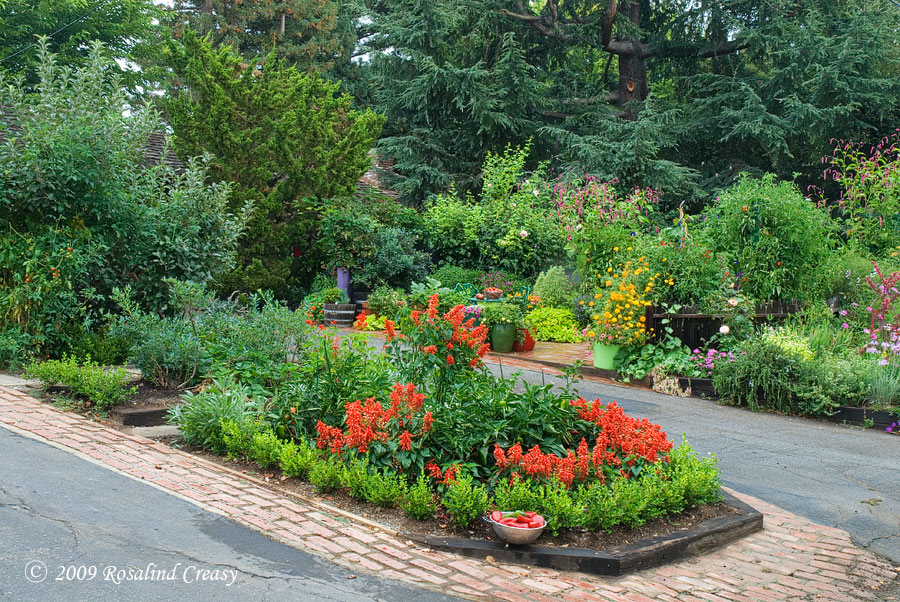
Rosalind Creasy’s front patio and driveway. You can see blueberry bushes on the far left. There are also peppers, strawberries, potted vegetables, edible flowers, and a dwarf apple tree.
-
The Color-Coordinated Edible Landscape
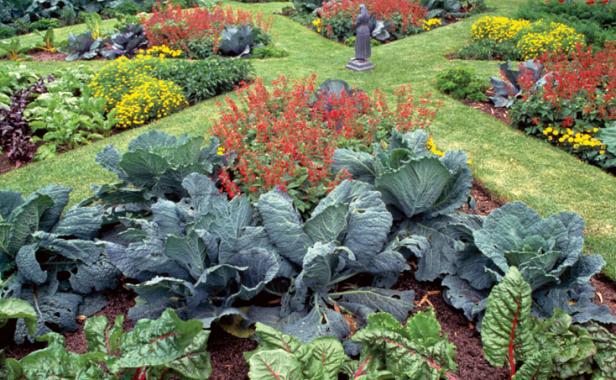
David Cavagnaro, co-founder of the Pepperfield Project in Iowa, took this photo of a vegetable garden (see the cabbages and chard?) on his farm. I love the careful use of color and the precise pattern of the walkways.
-
Small-Space Plant Extravaganza
The deep green of these plants tells me the soil is really rich (or they’re fertilizing a lot…). There’s a plan for this small edible landscape on Sunset.com. Photo by Rob Brodman.
-
Ultra-Raised Beds
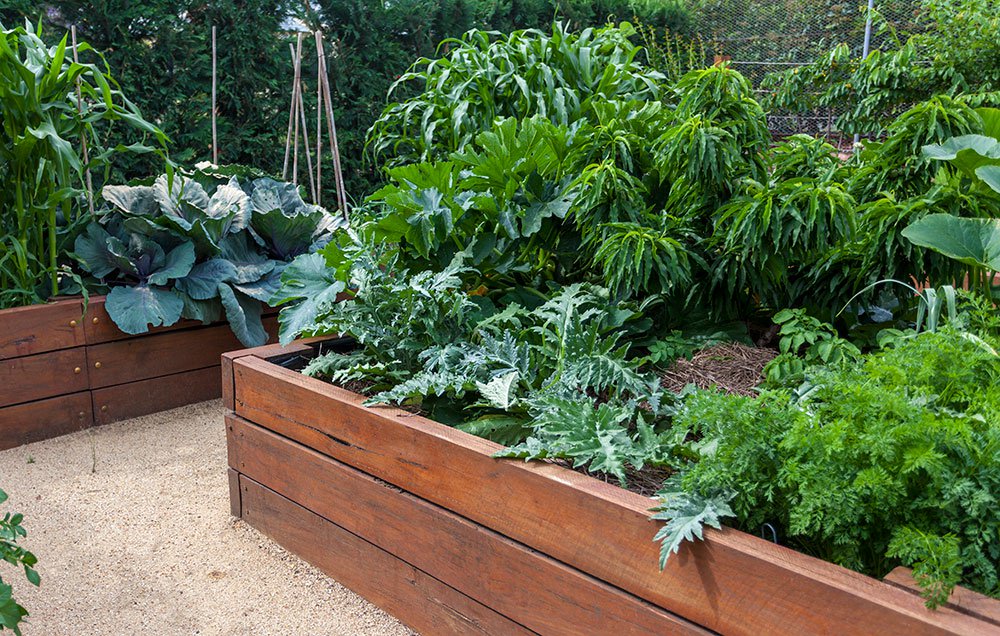
Raised beds allow for better drainage. We do have raised beds in our garden, but we didn’t need to raise them this high. (I’m glad, since we couldn’t have afforded this project!)
These beds, when planted, give a sense of mystery because you can’t see the whole garden at once. They’re also much easier on your back because you can work without bending over very much. Photo by Anna Green for Rodale.
-
The Beautiful Salad-in-the-Front Yard
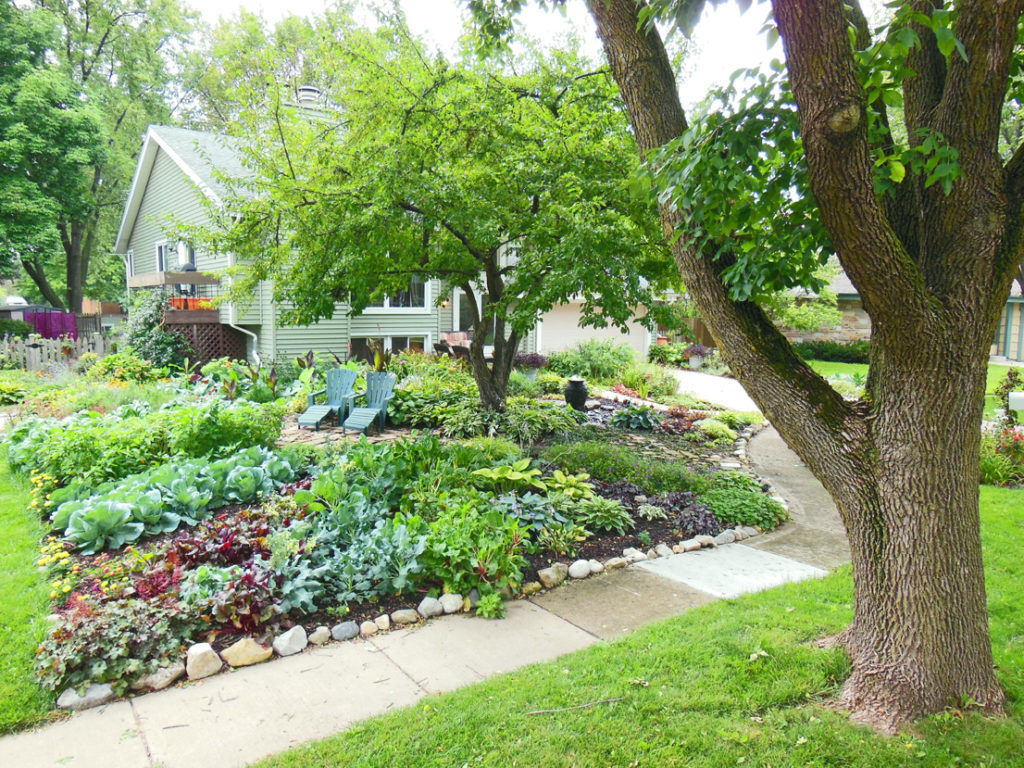
Shawna Coronado’s front yard.
The cabbages, Swiss chard, greens, herbs, and ornamental plants combine to make an absolutely stunning piece of art. (However, it would bother me that so much of your front yard will probably be bare in the winter unless you live in an area that gets a lot of snow.) This is a great example of an edible landscape with annuals.
-
Berries as Foundation Plantings
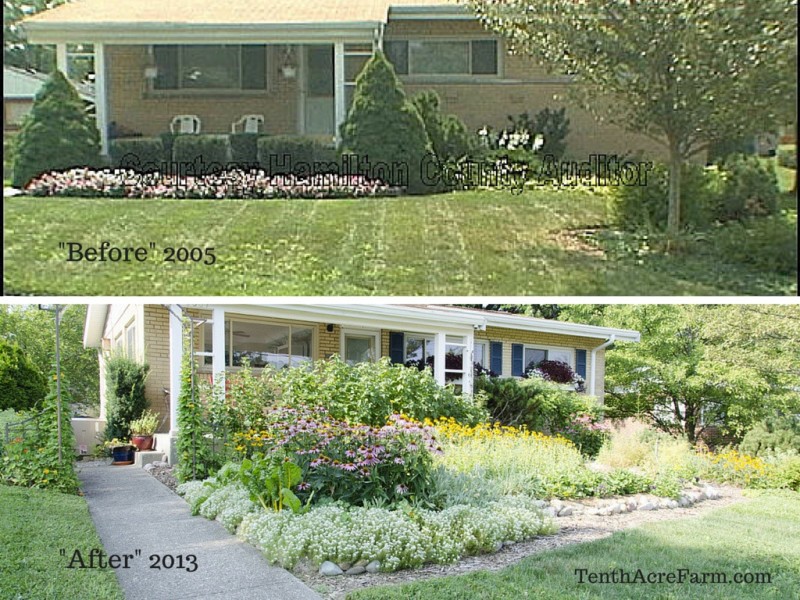 Amy Stross, who writes the Tenth Acre Farm blog, replaced her family’s standard subdivision shrub plantings with red and black currants, black raspberries, echinacea, greens, and other edible landscaping options. She took the same approach we are–plant annuals until you can afford perennials. (We will be starting out with a few blueberry plants before branching out
Amy Stross, who writes the Tenth Acre Farm blog, replaced her family’s standard subdivision shrub plantings with red and black currants, black raspberries, echinacea, greens, and other edible landscaping options. She took the same approach we are–plant annuals until you can afford perennials. (We will be starting out with a few blueberry plants before branching out to raspberries and blackberries. And in our front yard, where I’ve started an herbs-and-roses garden, we’ve been filling in with zinnias, cilantro, and anything else that’s cheap and easy to grow from seed.)
-
The 100-Square-Foot Garden
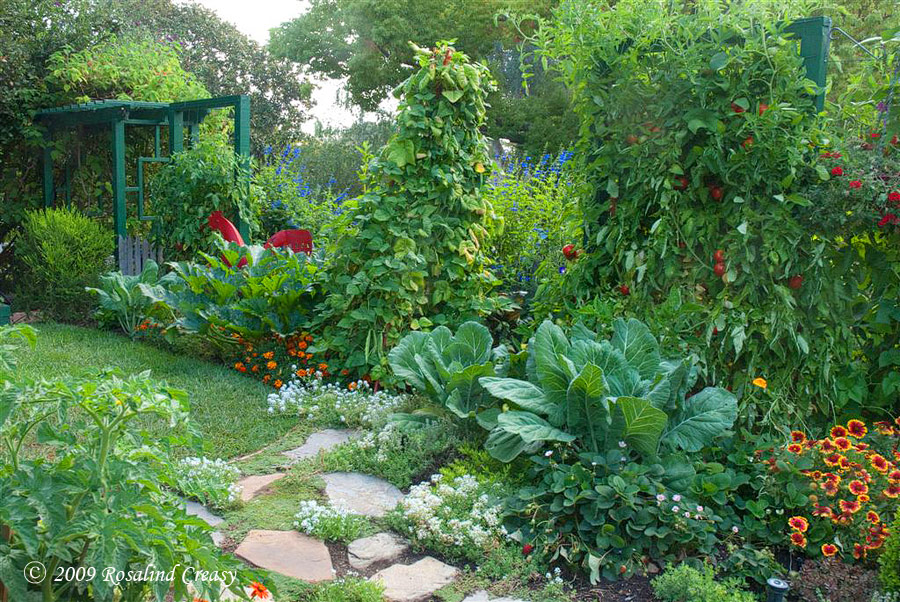 Rosalind Creasy’s experiment on 100 square feet shows her garden at different stages of growth and with different plants. Here, you can see tomatoes, runner beans, zucchini, cabbage, strawberries, and a number of flowers. Because the garden runs along the edge of a fence, it wouldn’t look as bare when everything died. (She lives in CA, though, so she never has a completely dead period in her garden! Must be nice!)
Rosalind Creasy’s experiment on 100 square feet shows her garden at different stages of growth and with different plants. Here, you can see tomatoes, runner beans, zucchini, cabbage, strawberries, and a number of flowers. Because the garden runs along the edge of a fence, it wouldn’t look as bare when everything died. (She lives in CA, though, so she never has a completely dead period in her garden! Must be nice!) Here’s a quote from her after figuring out how much produce 100 square feet yielded:
I started crunching numbers. According to the Garden Writers Association’s 2009 surveys, 84 million U.S. households garden. If only half of them—42 million—took out a 5-by-20 foot area of lawn and grew a 100-square-foot garden, that would take 96,419 acres (150 square miles) out of lawn cultivation… Granted, I’m an experienced gardener with great soil, so if those gardeners got half the yield I did, the savings on fresh produce would be: $14.4 billion!!!
-
Gorgeous Herb Gardens
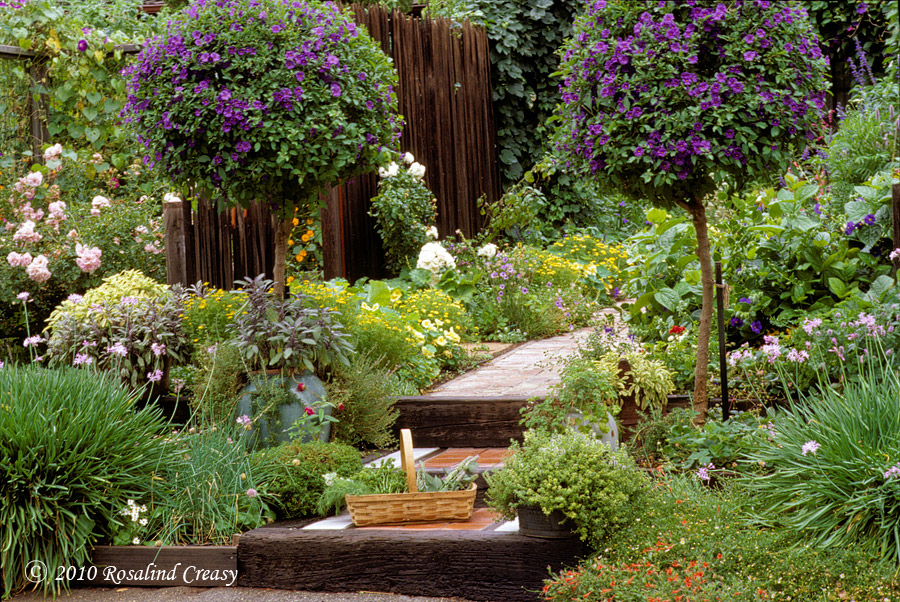
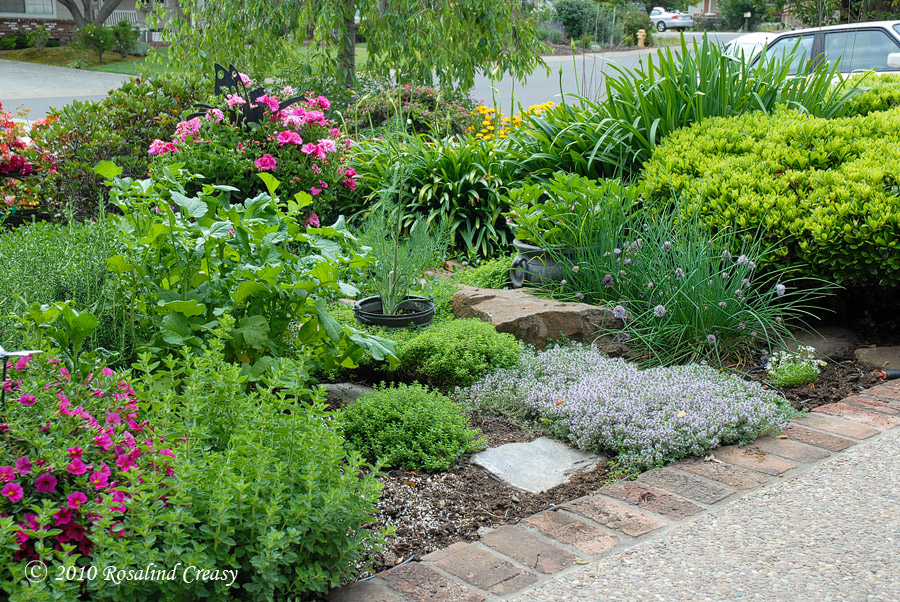 More edible landscape ideas from Rosalind Creasy, this time using primarily kitchen herbs.
More edible landscape ideas from Rosalind Creasy, this time using primarily kitchen herbs. -
Formal Vegetable Garden
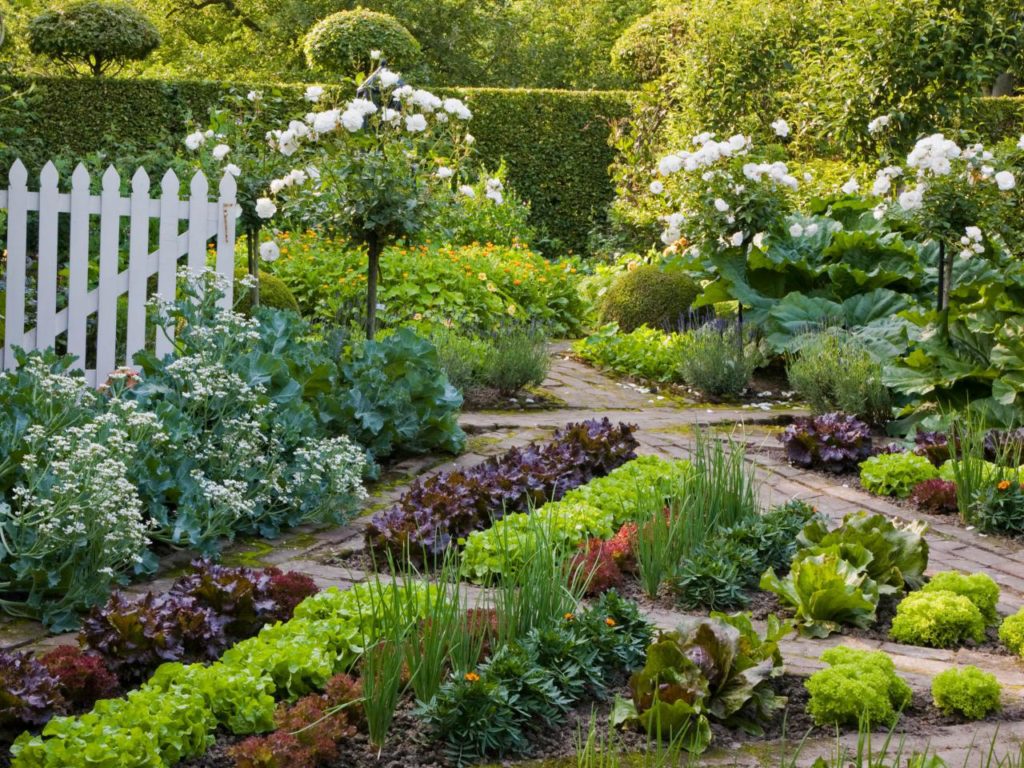
This gorgeous and very precise design was featured on HGTV’s website. I love the way this looks, but I never can gather up the courage to thin out plants that are out of line. I love them all…
-
Herbs and Berries as the Backbone of the Garden
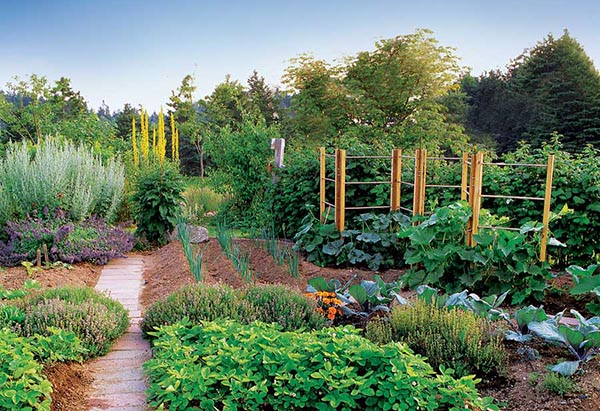
Beautiful garden in Maine. Photo from Organic Pest Control City.
This garden plan is too big for my little, fenced-in backyard. But I love the idea of using berries and herbs as perennial anchors of the edible landscape.
-
The Wheel
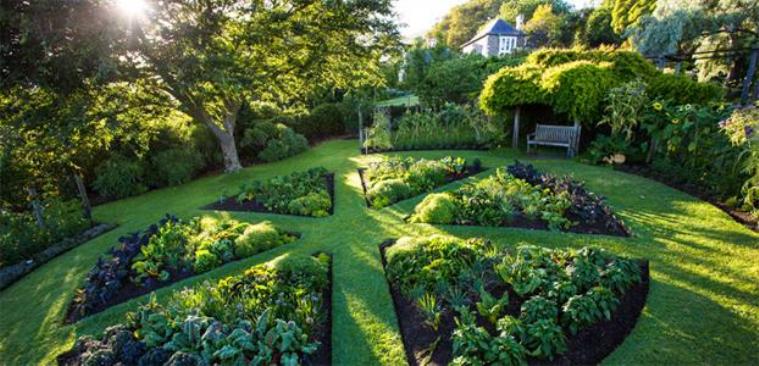
Formal Garden with Perennial Plants. Photo from We Are Found.
Yes, I always fall for that circle shape. This garden is in shade in the picture, but clearly gets plenty of sun during the day.
-
My Parents’ Back Yard
Any article of mine about gardening without a mention of my parents would be lacking something! With six kids, my family was mostly interested in food production. We dug up all the St. Augustine in the back yard and replaced it with straight raised beds. The tall Arkansas pine trees behind us gave some shade to the back part, but not the hill leading up to the house. I think these pictures show that any kind of plant in masses, terraced on a hillside to stop erosion, can be beautiful. Even if they’re not marked ornamental! Here are a few pictures of their organic garden after ten years of working on the soil by adding leaves, etc. (They no longer live here, so these pictures are from 2 years ago.)
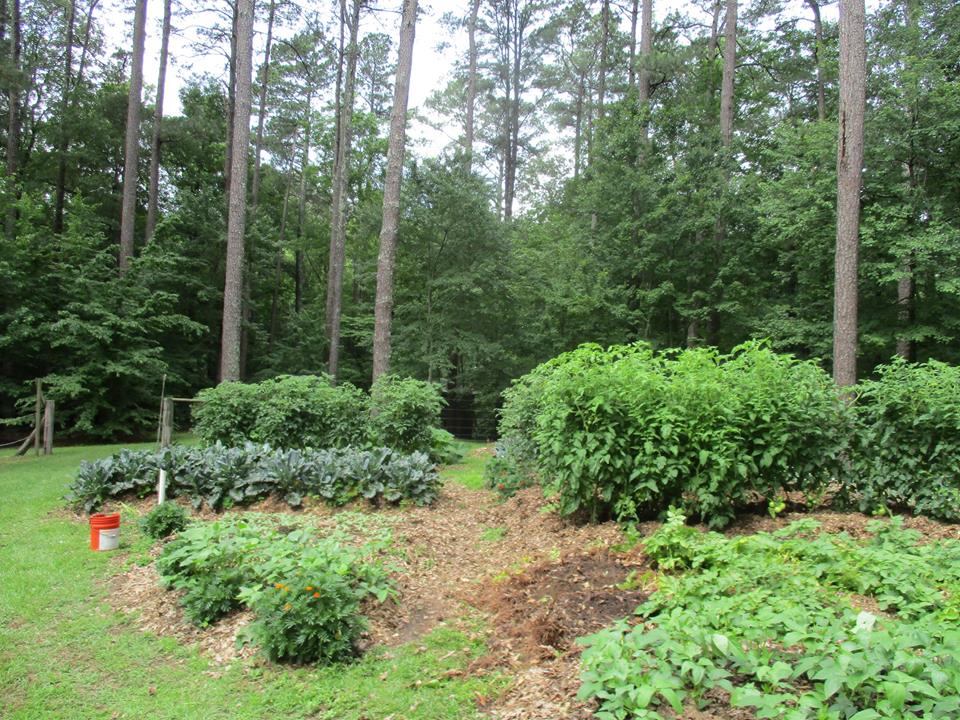
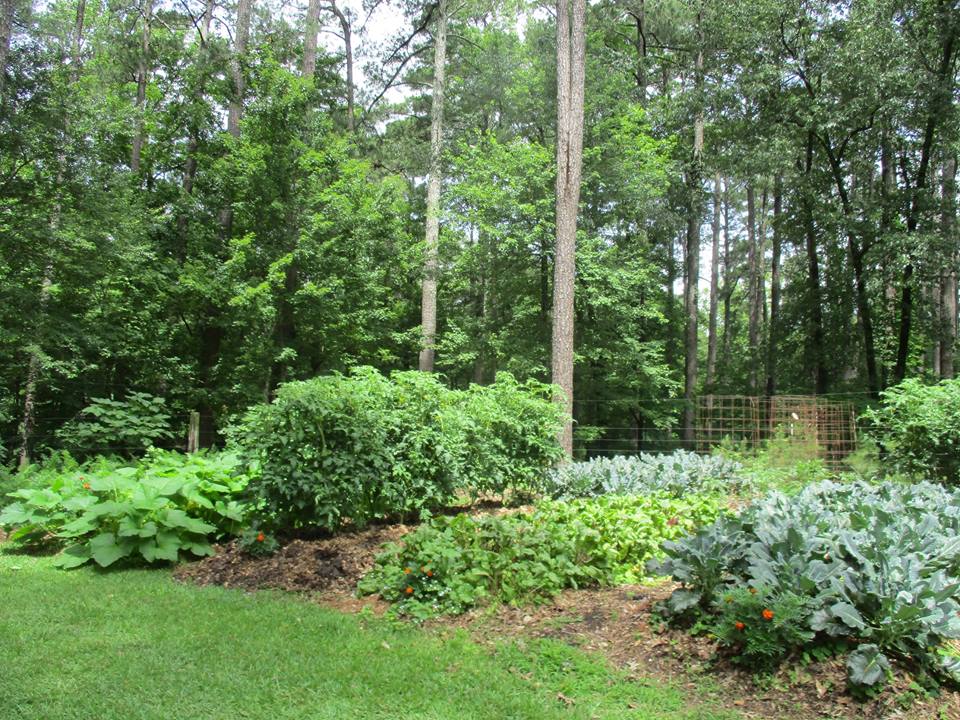
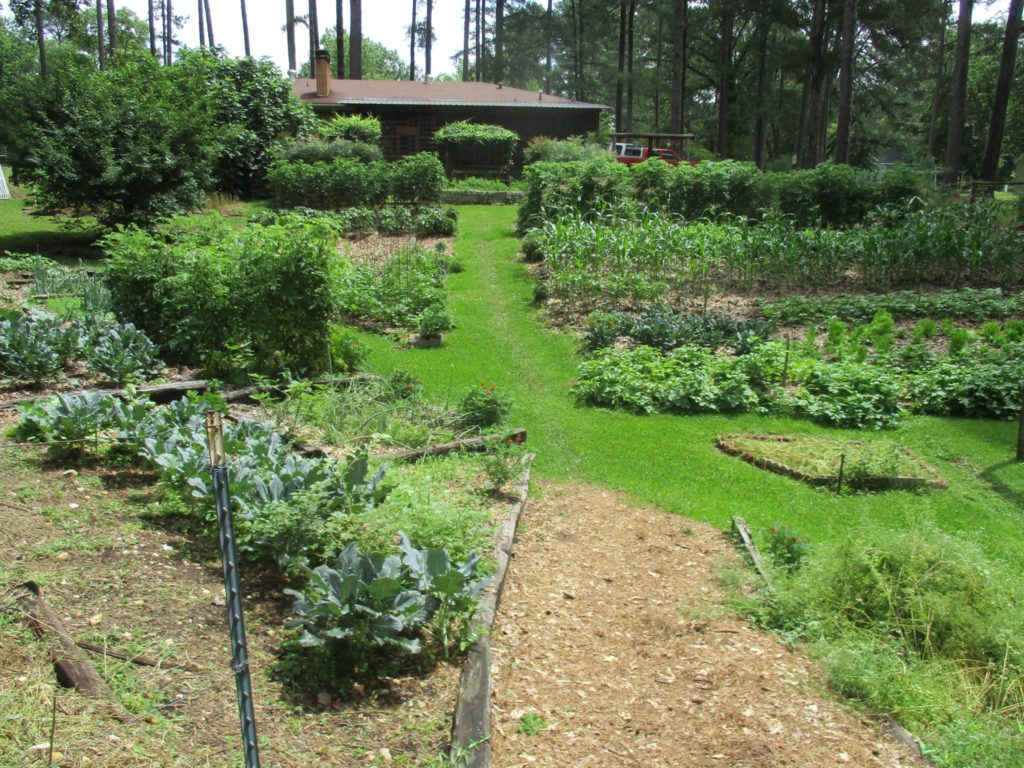
What you’re seeing in the picture above: kale, cilantro (leaning down in the right foreground), a path that leads to an arbor of muscadine vines (not pictured), muscadine vines covering a picnic table and grill by the house, tomatoes only half the height they ended up (over 7 feet tall by the end of the summer), and corn. Also, it looks like potatoes are leaning forward over the lawn in one of the last garden beds. A small odd-shaped garden is covered with mulch from the plants that had been growing there. A plum tree stands on the left side in the middle. I can also see a bed of bell peppers, more greens, and lettuces. What you can’t see are the beds of raspberries on either side and the blueberry bushes just to the left. The pictures above this one show the garden behind this one, where the leaf-covered path leads. You can see more tomatoes, squash, marigolds, etc.
For dozens of other pictures and tips to inspire your journey toward an edible landscape, follow me on Pinterest!
Here’s a link to the board I use to inspire myself: Edible Landscaping.
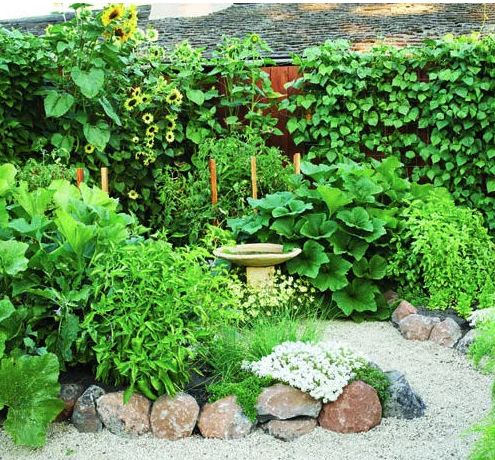


 : a favorite place to walk when we can!
Once
: a favorite place to walk when we can!
Once 
![The first photos are of my parents’ sprawling rural Arkansas garden. The last is of my tiny little beds in the big city. Plants bring life to even the smallest corner!
I’ve been reading some beautiful fiction this year, and I just posted a review of a book by one of my favorite authors, Leif Enger. (https://therestfulhome.com/brave-young-handsome-review/ in your browser, or click on the link in my Instagram profile) If you don’t have time to read the book, though, here’s just a quote or two for your enjoyment:
🎼
“Death arrived easy as the train; [he] just climbed aboard, like the capable traveler he was.”
🛤️
On riding a horse: “You are a feeble and tenuous being; the only thing a horse wants from you is your absence.” 🐎 😄
#quotes #leifenger #amreading #gardens #gardening](https://scontent-atl3-1.cdninstagram.com/v/t39.30808-6/468657020_18342474787176025_4442629541396867851_n.jpg?_nc_cat=108&ccb=1-7&_nc_sid=18de74&_nc_ohc=DEja6UP2ct4Q7kNvgEYJxCM&_nc_zt=23&_nc_ht=scontent-atl3-1.cdninstagram.com&edm=ANo9K5cEAAAA&_nc_gid=AA4bBsvQ_JpqZXLUPUTpTC8&oh=00_AYCjI9LUx-cJxe6cu0n7H1Gounaz92aBlTrQacnKut8umg&oe=67567CAB)
















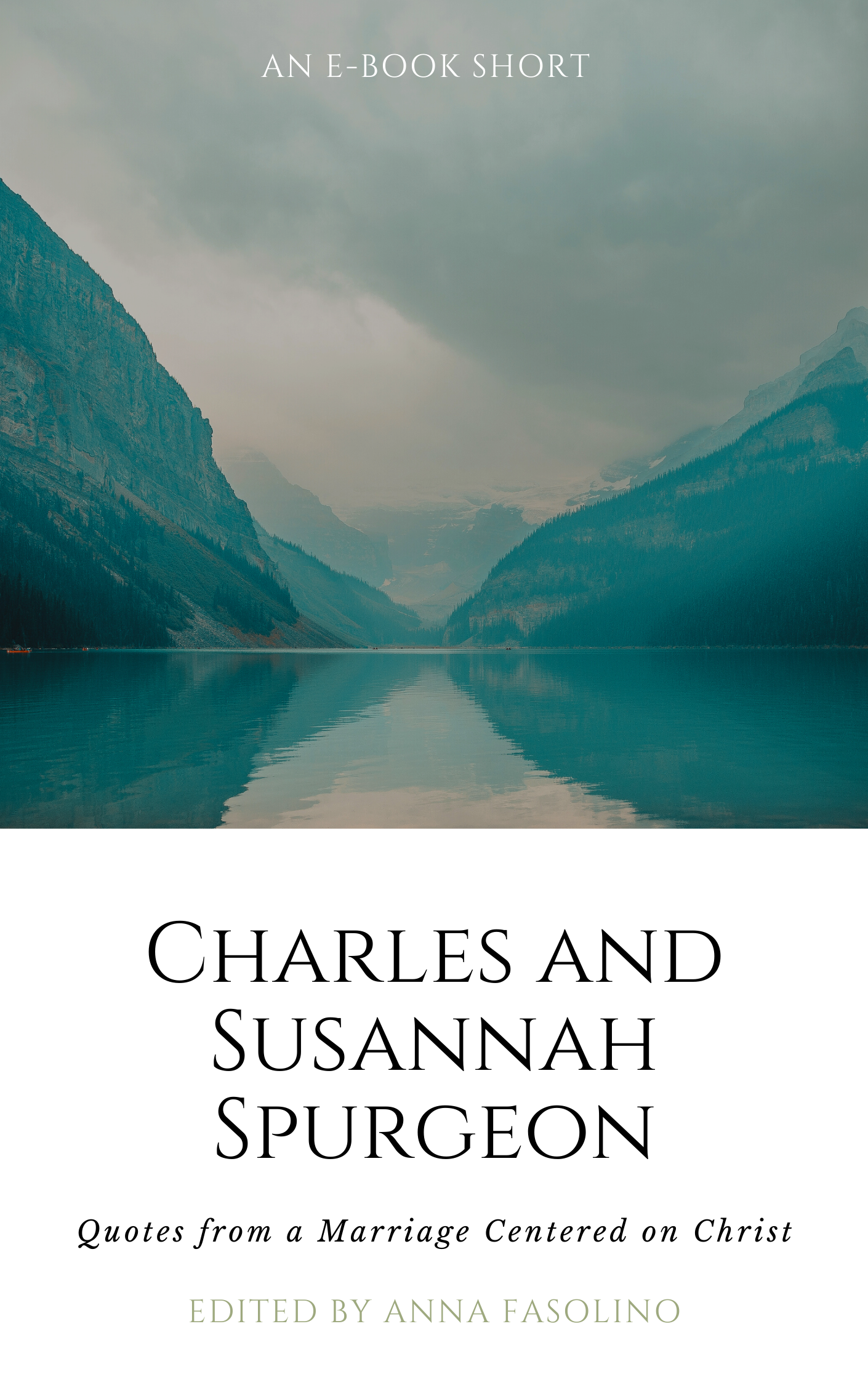
[…] quite a few I checked out of the library and read were Edible Landscaping (more on that HERE) and Square Foot Gardening, which was incredibly helpful despite the original version’s sad […]